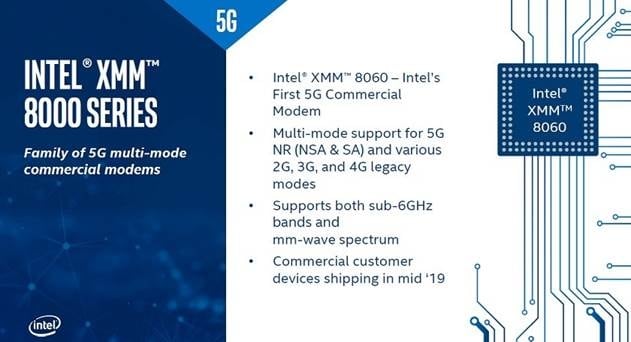Intel announced its first family of 5G new radio (5G NR) multi-mode commercial modems, the Intel XMM 8000 series and its latest gigabit-class LTE modem, the Intel XMM 7660.
Intel also announced it has successfully completed a full end-to-end 5G call based on its early 5G silicon, the Intel 5G Modem – a key milestone in its development.
A summary of Intel’s wireless roadmap updates includes:
Intel XMM 8000 series: Intel’s family of commercial 5G multi-mode modems, operating in both sub-6 GHz and millimeter wave global spectrum bands. The series will enable a range of devices to connect to 5G networks – from PCs and phones to fixed wireless consumer premise equipment (CPE) and even vehicles.
Intel XMM 8060: Intel’s first commercial 5G modem is capable of delivering multi-mode support for the full 5G non-standalone and standalone NR, as well as various 2G, 3G (including CDMA) and 4G legacy modes. Expected to ship in commercial customer devices in mid-2019, the Intel XMM 8060 will accelerate deployment of 5G-ready devices prior to anticipated broad deployment of 5G networks in 2020.
Intel XMM 7660: Intel’s latest LTE modem delivers Cat-19 capabilities and supports speeds up to 1.6 gigabits per second. This powerful LTE modem features advanced multiple-input and multiple-output (MIMO), carrier aggregation and a broad range of band support. It will ship in commercial devices in 2019.Additionally, Intel is helping set the pace for the industry with the Intel5G Modem.
Announced at CES 2017, Intel’s early 5G silicon is successfully making calls over the 28GHz band.
Dr. Cormac Conroy, Corpoate VP and GM of the Communication and Devices Group, Intel
Intel is committed to delivering leading 5G multi-mode modem technology and making sure the transition to 5G is smooth. Our investments in a full portfolio of modem technologies and products are critical to achieving the vision of seamless 5G connectivity.
Sandra Rivera, SVP and GM of the Network Platforms Group, Intel
Today’s wireless networks are the equivalent of data driving down a single-lane highway; tomorrow’s will need to serve as a multilane superhighway as data moves at warp speed with 5G networks.


















